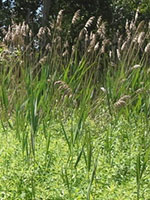
Phragmites australis
Common Reed
Chambly Canal National Historic Site
Description
The common reed is a perennial plant of the grass family and is native to Eurasia.
Reproduction occurs through underground and aerial stems (Figure 1) and seeds (vectors of propagation: wind, poorly cleaned or uncleaned vehicles during work, boots, movement of soil/equipment/vehicles from one site to another, animals, etc.) (Figure 2).


How to recognize the common reed?
| FLOWERING | August to September |
| FLOWERS | Feather-shaped (panicle), 20 to 30 cm, first purple then dark brown at maturity. |
| ROOT | Rhizomes that extend over several metres. |
| STEM | Green, then brown. |
| PLANT HEIGHT | Up to 4 metres. |
Spread
Through stolons (creeping aerial and underground stems). Extend like tentacles in all directions.
Positive and negative impacts
On vegetation: The density of the leaves of the reed prevents the survival and competition of other plants. Areas invaded by the common reed are therefore generally poor in vegetation.
On invertebrates: Areas invaded by the common reed are generally lower in invertebrate richness and abundance.
On fish: Larger fish may benefit from protection from predators given the abundance of the common reed and also find food there. For smaller fish, juveniles and larvae, this is an area where access is difficult due to the non-penetration of the tidal wave.
On reptiles: Adverse impacts on turtles, as eggs covered under the ground need sunlight to warm up and the reed blocks that sunlight.
On birds: Positive effects on certain species that are better adapted to all types of environments (song sparrow, red-winged blackbird, yellow warbler, etc.). Adverse effects on species that do not find the right material in reed marshes (ducks, geese, great blue heron, etc.).
On infrastructure: Stems can pierce asphalt and pool covers. The dead stems are flammable and represent a danger during heat waves.
Prevention method: mowing
For species that disperse rapidly and require mowing, proper disposal of clippings is required. A single fragment can be transported further, implant itself in the soil and produce new stems.
- Do not compost common reed plants.
- Use thick plastic bags to dry/rot the plants in the sun, then burn them when the they are dry and dead.
- Place plant residue in a leak-proof container or heavy plastic bags and dispose of it in a sanitary landfill that accepts it.
After mowing, it is desirable to revegetate the site with Indigenous species that delay the spread of the common reed, such as cattail, willow, shade creating bushes, etc.
Related links
- Date modified :


